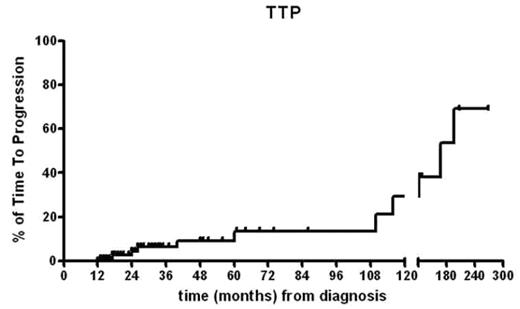Abstract
INTRODUCTION Plasma cell disorders are a group of diseases characterized by the proliferation of a plasma cell clone which produces a monoclonal protein (M protein). The most common type is Monoclonal Gammopathies of Undetermined Significance (MGUS), followed by multiple myeloma (MM) and Waldenstrom’s Macroglobulinemia (WM). In particular, the frequency of MGUS increases with age and its rate of progression is approximately 1% per year. Because of the high prevalence and the different fields of clinical practice in which these patients are followed, it could be of great interest to know the epidemiology of these diseases out of the Hematology Units.
AIM OF THE STUDY to describe the frequency and the progression risk of plasma cell disorders in a General Hospital during more than a twenty-year period.
METHODS We retrospectively reviewed the medical records of patients with diagnosis of MGUS, MM or WM seen at our center from 1984 through 2006. Statistical analysis were performed using GraphPad Prism 4 (GraphPad Software, Inc.).
RESULTS The study included 102 patients: 78 affected by MGUS (76%), 14 by MM (14%) and 10 by WM (10%). Patients’ clinical features are summarized in the Table. Median follow-up was 48 months (range:12–280). Among the 89 patients with a first diagnosis of MGUS, malignant transformation occurred in 11 patients (7 MM and 4 WM). The median time from diagnosis of MGUS to diagnosis of a lymphoplasma cell proliferative disorder was 60 months (range 12–196). Median time to progression (TTP) was 167 months, as shown in Figure. The cumulative probability of progression was 13.5% at 5 years and 29.2% at 10 years. The amount of serum M protein at diagnosis was a significant predictor of progression.
CONCLUSIONS MGUS are very common in clinical practice, accounting in our study for more than 75% of plasma cell disorders. The premalignant nature of this condition is comfirmed by the rate of transformation in lymphoplasma cell proliferative disorders (50% of MM and 40% of WM, in this study). Even if our results may be biased by the short follow-up period, the only significant predictor of progression was the size of serum M protein at presentation.
Patients’ characteristics
| Characteristics . | MGUS . | MM . | WM . |
|---|---|---|---|
| Gender male/female | 41/37 | 4/10 | 7/3 |
| Age at diagnosis median (range) | 69 yrs (30–91) | 72 yrs (51–90) | 75 yrs (67–85) |
| Serum M protein median (range) | 1.26 g/dl (0.17–2.92) | 3.85 g/dl (0.62–8.10) | 3.20 g/dl (2.22–4.9) |
| Isotype | |||
| IgG | 46 | 8 | - |
| IgA | 14 | 6 | - |
| IgM | 15 | - | 10 |
| biclonal | 3 | - | - |
| Immunoparesis yes/no | 20/58 | 14/0 | 10/0 |
| BJ proteinuria pos/neg | 11/67 | 11/3 | 1/9 |
| Characteristics . | MGUS . | MM . | WM . |
|---|---|---|---|
| Gender male/female | 41/37 | 4/10 | 7/3 |
| Age at diagnosis median (range) | 69 yrs (30–91) | 72 yrs (51–90) | 75 yrs (67–85) |
| Serum M protein median (range) | 1.26 g/dl (0.17–2.92) | 3.85 g/dl (0.62–8.10) | 3.20 g/dl (2.22–4.9) |
| Isotype | |||
| IgG | 46 | 8 | - |
| IgA | 14 | 6 | - |
| IgM | 15 | - | 10 |
| biclonal | 3 | - | - |
| Immunoparesis yes/no | 20/58 | 14/0 | 10/0 |
| BJ proteinuria pos/neg | 11/67 | 11/3 | 1/9 |
Figure
Author notes
Disclosure: No relevant conflicts of interest to declare.


This feature is available to Subscribers Only
Sign In or Create an Account Close Modal